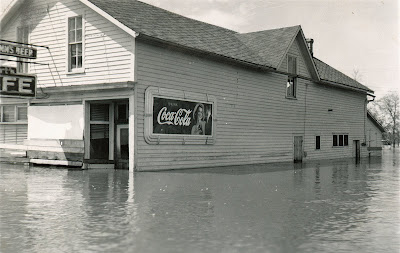 |
| Population 6...plus two big dogs [Photo: Ghosts of Minnesota] |
One of them is Tenney, Minnesota.
Tenney recently dissolved, meaning they are no longer a town. I can't help but realize that it's only a matter of time before St. Vincent has to face that decision.
When I was growing up, St. Vincent had around 200 people. It was already in its descendency, a shadow of what it once was. But there were hints of its glory days, such as the sidewalks - some sections had been maintained well, others were disappearing under encroaching soil and grass. We still had a general store, a gas station (two, when counting the Junction), a post office, a school, and four churches (St. Anne's Catholic Church, Valley Community Church - later known as St. Vincent Evangelical Free Church - Christ Church, and the Plymouth Brethren Church. We also still held an annual fall event, the St. Vincent Fair (which was at one time, vying to be the county fair. Despite Hallock prevailing, St. Vincent continued their fair tradition for many years, and people from around the area continued to enter their produce, livestock, hand work, and baked goods in friendly (but deadly serious) competition!
But I digress. The point here is, all of that is long gone. It echos in my mind how my mother and grandmother used to talk wistfully about what the town used to be like, all the life of the town now gone, they said - businesses, families, parks, public concerts and socials. They pointed out here was where a saloon was, there was where the blacksmith's shop was. Across the road by that alley - which was actually the old railroad track bed - was where the depot used to be. On a trip with my father to the nuisance ground, my mother told me that was where the park used to be, and there was a gazebo there, where town brass bands would play on Sunday afternoons. The fair itself used to be down by the river once, too, but later was held in the downtown. Exhibits were in the Quonset, near the old temporary holding pens once used by the railroad for livestock, now used for sheep, hogs, etc. at fair time.
Now there are only around 60 souls. Every block has vacancies, empty space where once stood homes and businesses, where circumstances have, like a cancer, dictated surgical removals. Natives like myself can walk the streets, seeing and hearing what once was. Like ghosts bearing witness, it is all too real. The poignancy is very bittersweet. I once saw a movie that hit all too close to home, and it made me think how my hometown was headed in that same direction.
Most people don't face a death in the family involving their hometown, but that is how it feels to me. St. Vincent has never just been where I'm from, it's my family. All those souls from the past, that I grew up with, related by blood or by just being neighbors, were not merely faces and names to me, but family. I miss them all, and their memories will never fade from my mind as long as I am alive. This blog is testimony to them as much as I am able to make it...










